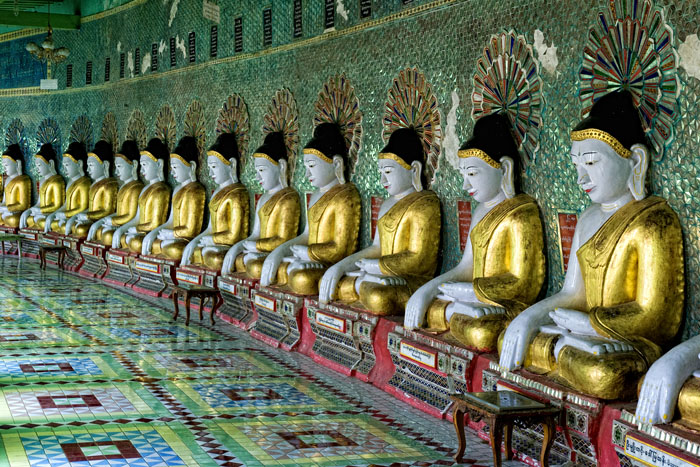Sagaing is a religious sanctuary with the town at the foot of the hills and hundreds of pagodas, monasteries and nunneries tucked into the surrounding valleys and hills. Some monasteries are magnificently built of brick in a combination of Western and Myanmar architectural designs while some are of teak. Trees cover the hills so that the monasteries and nunneries are often hidden from view until one turns a corner and they suddenly loom up like magical mansion.
Monywa
The second largest city in Sagaing Division after Sagaing. It is near the confluence of the Ayeyarwaddy River and the Chindwin Tributary. It has very good communications with other places by land and river. It is a city very prosperous in trade. The Thanbode (a half million of Buddha images), Bode Tahtaung (a thousand Bo trees), a 300 foot long reclining Buddha image, Shwe Ba Hill and Po Win Taung Hill with over 400,000 numbers of 14th to 16th century ancient Buddha images and mural painting are major places for the visitors.”
Shwe Bo
Shwebo is a city in the Sagaing Region of Myanmar, located 64 miles (103km) north-west of Mandalay on the eastern bank of the Chindwin River. Shwebo was the native town of King Alaungpaya, the founder of the Kone Baung Dynasty. Shwebo was royal capital of Myanmar from 1760-1764. King Alaungpaya fought against the rule of the Mon Monarchy in 1752, and his dynasty lasted over two centuries. He used the city as a base from which to conquer Innwa and Lower Myanmar, establishing the Third Myanmar Empire. His successor, King Hsinbyushin, moved the capital to Amarapura in the 1780s, and the city has been in decline ever since. Shwebo is also called in five different names. Moksobo, its original name Yadana-Theinhka, Konbaung, Yangyi-Aung and Shwebo, its modern name. As with Monywa, the city is a trade center for agricultural produce, especially beans, rice and sesame from the surrounding plains between the Mu and the Ayeyarwady River. The area around Shwebo was the site of the anient Pyu city-state of Hanlin.



Comments